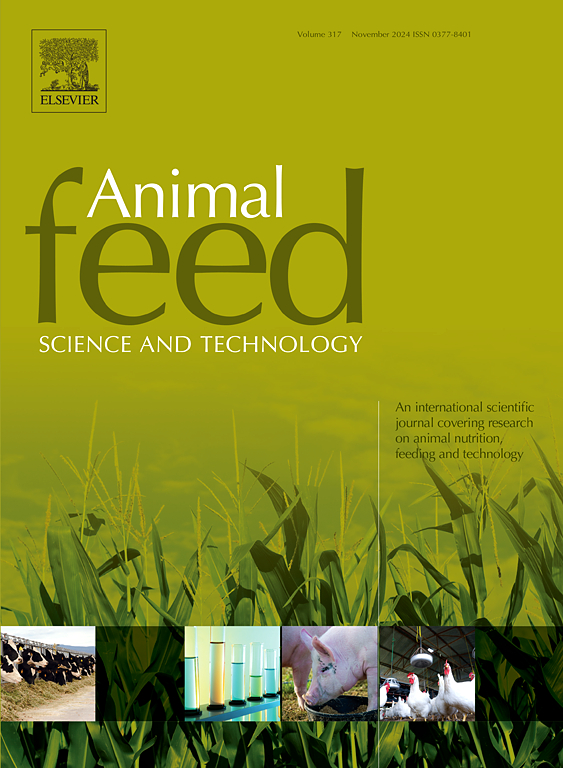葵花籽加全脂油菜籽对肉鸡生产性能、表观回肠消化率和肠道形态的影响
IF 2.7
2区 农林科学
Q1 AGRICULTURE, DAIRY & ANIMAL SCIENCE
引用次数: 0
摘要
采用2 × 2因子试验,研究了添加向日葵壳作为不溶性纤维对饲粮中添加全脂油菜籽(CS)肉鸡11 ~ 42日龄生产性能和部分生理参数的影响。选取240只1日龄肉鸡(Ross 308),随机分为4个处理,每个处理6个重复,每个重复10只鸡。处理为菜籽油源(CS和菜籽粕加油)和葵花籽壳(0和30 g/kg)。在11 ~ 24日龄(生长期),菜籽油源与SFH水平对生产性能无显著交互作用(P >; 0.05)。与不添加SFH和CS的饲料相比,添加30 g/kg的SFH和菜籽油可提高饲料增重(BWG),降低饲料系数(FCR) (P <; 0.05)。在25-42日龄(育肥期),在CS日粮中,与不添加SFH的日粮相比,添加SFH降低了FCR (P <; 0.05)。在整个试验期内,饲喂SFH的肉鸡生产性能优于未饲喂SFH的肉鸡(P <; 0.05)。饲粮中添加菜籽油可降低采食量,提高饲料比。在菜籽油饲粮中添加SFH导致相对砂囊重量比不添加SFH的饲粮重,而在CS饲粮中对该器官没有影响,导致CS与 SFH水平相互作用(P <; 0.05)。添加SFH可提高菜籽油饲粮中回肠有机物(OM)和粗蛋白质(CP)的消化率(P <; 0.05)。在两种饲料中,与不添加SFH的饲料相比,添加SFH的饲料中乳酸杆菌的数量增加(P <; 0.05),但菜籽油的效果比CS饲料更明显。在CS饲粮中,与不添加SFH的饲粮相比,添加SFH导致大肠杆菌数量降低(P <; 0.05),而菜籽油饲粮对大肠杆菌数量没有影响。饲喂SFH的雏鸟十二指肠绒毛高度(VH)、空肠绒毛高度(VH)和上皮厚度(ET)均高于未饲喂SFH的雏鸟(P <; 0.05)。综上所述,在肉鸡饲粮中添加SFH可对肉鸡生长性能无负面影响,对肠道形态有有益影响。在添加SFH的肉鸡饲粮中添加菜籽油可提高营养物质的消化率。本文章由计算机程序翻译,如有差异,请以英文原文为准。
Changes in performance, apparent ileal digestibility and intestinal morphology of broiler chickens fed diets containing sunflower hulls with full-fat canola seed
The effect of addition of sunflower hulls (SFH) as an insoluble fiber on performance and some physiological parameters of broiler chickens fed diets containing full-fat canola seed (CS) was evaluated from 11 to 42 d of age in a 2 × 2 factorial arrangement of treatments. A total of 240 one-day-old broilers (Ross 308) were randomly devoted to 4 treatments, with 6 replicates each and 10 birds per replicate. Treatments were canola oil source (CS, and canola meal plus oil) and sunflower hulls levels (0 and 30 g/kg). During the 11–24 d of age (Grower period), canola oil source and SFH levels had no (P > 0.05) significant interactions on performance. The 30 g/kg SFH inclusion and canola oil resulted in higher body weight gain (BWG) and lower feed conversion ratio (FCR) compared to those fed without SFH and CS diets (P < 0.05). During the 25–42 d of age (Finisher period), in the CS diets, the SFH inclusion reduced (P < 0.05) FCR compared to the diet without SFH. Over the whole trial period, broilers receiving SFH had better (P < 0.05) performance compared to those fed without SFH. Feeding diets with canola oil reduced feed intake (FI) and improved FCR when compared to CS. The inclusion of SFH resulted in a heavier relative gizzard weight than diets without SFH in the canola oil diets, whereas had no effect on this organ in CS diets, resulting in a CS × SFH level interaction (P < 0.05). The inclusion of SFH increased (P < 0.05) ileal organic matter (OM) and crude protein (CP) digestibility in the canola oil diets. In both diets, the inclusion of SFH increased (P < 0.05) the numbers of the Lactobacillus spp. in comparison with diets without SFH, but this effect was more pronounced in canola oil than CS diets. In the CS diets, feeding SFH resulted in lower (P < 0.05) numbers of Escherichia coli in comparison with diets without SFH, while in canola oil diets, it was not influenced. Birds fed SFH showed a greater (P < 0.05) duodenal villus height (VH) and jejunal VH and epithelial thickness (ET) than those fed without SFH. Overall, the current results suggest that whole CS, if supplemented with SFH, can be used in broiler diets without negative effect on the growth performance with beneficial effects on intestinal morphology. Inclusion of canola oil in broiler diets with SFH can benefit nutrient digestibility.
求助全文
通过发布文献求助,成功后即可免费获取论文全文。
去求助
来源期刊

Animal Feed Science and Technology
农林科学-奶制品与动物科学
CiteScore
6.00
自引率
6.20%
发文量
266
审稿时长
3 months
期刊介绍:
Animal Feed Science and Technology is a unique journal publishing scientific papers of international interest focusing on animal feeds and their feeding.
Papers describing research on feed for ruminants and non-ruminants, including poultry, horses, companion animals and aquatic animals, are welcome.
The journal covers the following areas:
Nutritive value of feeds (e.g., assessment, improvement)
Methods of conserving and processing feeds that affect their nutritional value
Agronomic and climatic factors influencing the nutritive value of feeds
Utilization of feeds and the improvement of such
Metabolic, production, reproduction and health responses, as well as potential environmental impacts, of diet inputs and feed technologies (e.g., feeds, feed additives, feed components, mycotoxins)
Mathematical models relating directly to animal-feed interactions
Analytical and experimental methods for feed evaluation
Environmental impacts of feed technologies in animal production.
 求助内容:
求助内容: 应助结果提醒方式:
应助结果提醒方式:


